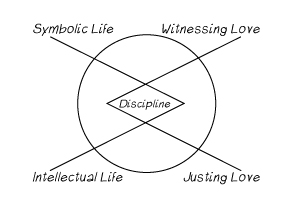First course – 1955
The Bug Model—so named because it looks like a bug—was developed at the Christian Faith and Life Community at a time when groups focused on their internal symbolic and intellectual life at the expense of fully engaging their external mission. It described the key tasks of a local congregation. It was one of the images used in early Ecumenical Institute courses and would become a prominent image for local colleague networks, known as Those Who Care.
My recollection is that the Bug Model was used in the first RS-I-like course which I did at the Faith and Life Community in Austin. This is the best I can do at the moment (Carl Caskey, email, August 14, 2014).
I believe Carl is correct. From my memory of RS-I at CFLC, [the Bug Model] was used in the church lecture, along with the wedge-blade image of the no longer and not yet.…the wedge-blade represented the mission of the church and the bug model represented how the church performed its mission (LiDoña Wagner, email, August 15, 2014).
Symbolic Life, refers to the rituals and symbols that rehearse the story of the group. Intellectual Life refers to corporate study done by the group to clarify its work. A group’s symbolic and intellectual life support it’s external task.
Discipline is represented by the…[diamond] which joins together the internal life (study and symbolic) and the external life (mission). Discipline refers to how one structures one’s use of time and goods (resources), i.e. time-task constructs, etc. The Bug Model applies to congregations, cadres, a family’s life, or any other effective group (George West, email, March 18, 2014).
The two external tasks are Witnessing Love—the declaration that releases people’s freedom; and Justing Love—the work that calls people to use the power of witnessing love to create equitable new social structures. Discipline refers to the corporate life style evolving out of the other four activities.

